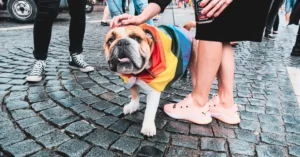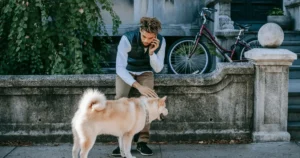Table of Contents
ToggleKey Takeaways for Socializing Your Dog with Humans
-
Start Early: Begin socializing your puppy between 3-14 weeks for maximum success.
-
Be Patient and Consistent: Socializing takes time—don’t rush your dog’s progress.
-
Use Positive Reinforcement: Reward your dog with treats and praise when they behave calmly around new people.
-
Respect Your Dog’s Comfort Zone: Every dog is different—take things at their pace.
-
Stay Calm and Confident: Dogs sense your energy—be a calm leader and guide them through the socialization process.
1. Why Socializing Your Dog with Humans Is Crucial
Socializing your dog with humans is one of the most important things you can do for their emotional and behavioral development. Proper socialization helps your dog become comfortable and confident around new people, reducing common issues like fear-based aggression or anxiety. Socializing not only promotes better behavior but helps your dog feel more secure in any situation.

Benefits of Socializing Your Dog with Humans
-
Reduces Anxiety & Aggression: Dogs that are well-socialized are less likely to bark, growl, or act defensively around humans. They are also more likely to approach new people with confidence.
-
Improves Behavior: Socialized dogs are more relaxed, making them easier to manage in public and private spaces.
-
Boosts Confidence: Dogs that are comfortable with people are more confident, reducing stress for both you and your pet.
2. When Should You Start Socializing Your Dog: Puppies vs. Adult Dogs
Puppies (3-14 Weeks)
The ideal time to begin socializing your puppy is between 3 and 14 weeks, as puppies are most impressionable at this stage. Exposing them to a variety of humans (men, women, children) during this time will shape how they react to people later in life.
-
Puppy Socialization Tips: Start with short and positive sessions introducing your puppy to different types of people. Try introducing them to both familiar and unfamiliar faces, including men, women, children, and those with different physical appearances (e.g., tall, bearded, or wearing glasses).
Adult Dogs & Rescue Dogs
Socializing adult dogs or rescue dogs can take more time, especially if they’ve had negative experiences with humans. However, it’s important to remember that it’s never too late to socialize your dog, and with the right approach, they can learn to behave positively around humans.
-
Adult Dog Socialization Tips: Start slow and control the environment. Introduce your dog to one calm person at a time, using treats and praise to reward good behavior. Over time, as your dog becomes more comfortable, you can gradually introduce more people.

3. Expert Tips for Socializing Your Dog with Humans
Step 1: Know Your Dog’s Comfort Zone (Threshold)
Each dog has a comfort zone. This is the distance at which they feel safe from a new person or situation. Start by observing your dog’s body language and adjusting the distance from any potential triggers until they are calm.
-
Start with Short Interactions: Begin with short interactions (around 5-10 minutes) and gradually increase the duration as your dog grows more comfortable around humans.
Step 2: Use Positive Reinforcement
Positive reinforcement is essential when socializing your dog. Whenever they display calm and friendly behavior around new people, reward them with a treat, praise, or even playtime. This helps your dog associate humans with positive experiences.
-
High-Value Treats: Use treats that your dog loves to reinforce positive interactions. For more information on training and behavior, visit this ASPCA Dog Training Tips.
Step 3: Take It Slow and Don’t Rush
Every dog progresses at their own pace, so don’t rush the process. If your dog seems nervous or uncomfortable, give them time to adjust. It’s crucial to avoid forcing your dog into situations they’re not ready for, as this can lead to negative associations with humans.
Step 4: Gradually Increase Exposure
Once your dog is comfortable with short, controlled interactions, you can gradually increase the exposure to more people and environments. Watch your dog’s body language closely to ensure they’re not becoming overwhelmed.
4. Signs Your Dog Needs More Socialization
If your dog is struggling in social situations or seems fearful or aggressive towards humans, it may be a sign that they need more socialization. Here are a few indicators that your dog may need additional help:
-
Excessive Barking or Growling: When meeting new people, your dog may exhibit fear or territorial behaviors like barking or growling.
-
Fearful Behavior: Hiding, backing away, or trying to escape indicates your dog is not comfortable around humans.
-
Aggression: If your dog displays aggression (snapping, lunging, or showing teeth), they may need further socialization training.
5. How to Overcome Common Socialization Challenges
Fear-Based Behavior
If your dog shows fear-based behavior, start by introducing them to one calm person at a time. Avoid overwhelming them by keeping interactions short and rewarding calm behavior with treats. This will help to create a positive association with human interactions.
Aggressive Behavior
Aggression can be a more complex issue, often stemming from fear or past trauma. A technique called counter-conditioning is highly effective. This involves gradually changing your dog’s emotional response to certain triggers, such as humans. In severe cases, seeking help from a professional dog trainer may be necessary.
6. When to Seek Professional Help for Socializing Your Dog
If your dog is not improving despite your efforts or if they are showing signs of extreme aggression or anxiety, it may be time to seek professional help. A certified dog trainer can develop a tailored behavior modification plan.
You can check out resources from the American Kennel Club (AKC) on dog socialization techniques.
7. Ongoing Socialization: Building Confidence in Your Dog for Life
Socialization is not a one-time process—it’s an ongoing journey that lasts throughout your dog’s life. Even adult dogs can benefit from continued exposure to new people and situations.
-
Routine Exposure: Regularly take your dog to parks, visit friends, and explore new environments to maintain their social skills.
-
Positive Socialization: Try enrolling in group dog classes to help your dog build confidence with both humans and other dogs. This can also help to further prevent behavioral issues.
FAQs: Everything You Need to Know About How to Socialize Your Dog with Humans
1. How do I get my dog to socialize with people?
Start by introducing your dog to one person at a time in a calm environment. Gradually increase exposure as your dog becomes more comfortable, using treats and praise to reinforce positive behavior. If you’re looking for tips, check out Tips to Prepare for Adopting a Cat or Dog.
2. What is dog socialization?
Dog socialization is the process of introducing your dog to different people, environments, and experiences to help them feel comfortable and confident. It’s essential for preventing behavioral issues like aggression or anxiety.
3. How do I make my dog more friendly with humans?
To make your dog more friendly, expose them to different people regularly. Use positive reinforcement to reward good behavior and avoid rushing interactions. Let your dog set the pace.
4. How long does it take to socialize a dog with humans?
The time it takes depends on the dog’s age and temperament. Puppies typically adapt in a few weeks, while adult dogs may take several months. Consistency is key!
Conclusion of FAQs
Socializing your dog with humans is essential for their well-being. Whether you have a puppy or an adult dog, following the right steps and seeking professional help when needed will ensure that your dog becomes confident and friendly around people.




